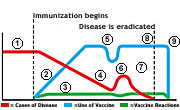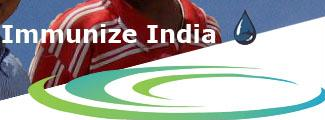Brief Description

Parents are constantly concerned about the health and safety of their children and they take many steps to protect them. These preventive measures range from child-proof door latches to child safety seats. In the same respect, vaccines work to safeguard children from illnesses Graph showing the life-cycle of an immunization program (Image and content adapted from: Chen RT, Rastogi SC, Mullen JR, Hayes S, Cochi SL, Donlon JA, Wassilak SG. The Vaccine Adverse Event Reporting System (VAERS). Vaccine 1994;12:542-50.)and death caused by infectious diseases. Vaccines protect children by helping prepare their bodies to fight often serious, and potentially, deadly diseases.
When there is no vaccine for a disease, the number of people getting the disease is usually high. People are worried about the disease and its effects.
When an immunization program for a disease begins, the number of people being vaccinated rises.
At the same time, there will be some adverse reactions associated with the vaccine -almost always very few and very mild compared with illness and complications associated with the disease.
As the number of people being vaccinated rises, the number of cases of disease drops. Eventually, the number of people getting the disease may approach the small number of people having adverse reactions. (This number remains fairly constant because it is a percentage of the number of people being vaccinated.).
At this point, most people may never have experienced the disease, and their attention turns from worry about the disease to concern about possible side-effects of the vaccine. People may start to question whether the vaccine is necessary or safe, and some people will stop getting immunized.
If enough people stop getting immunized, disease numbers will start to rise again, and there will be outbreaks.
People are reminded of how bad the disease can be, and turn back to immunization to avoid it. Vaccinations increase once more and disease declines.
Ultimately, we hope that enough people get immunized that the disease disappears altogether. (So far this has happened only with smallpox, but it could happen with other diseases, such as polio and measles, in the not-too-distant future.)
When there is no more disease, the immunization program can be stopped. The numbers of vaccinations and adverse reactions drop to zero.
The graph below demonstrates the above items.

Graph showing the life-cycle of an immunization program
Image and content adapted from:
Chen RT, Rastogi SC, Mullen JR, Hayes S, Cochi SL, Donlon JA, Wassilak SG. The Vaccine Adverse Event Reporting System (VAERS). Vaccine 1994;12:542-50.
Source
Chen RT, Rastogi SC, Mullen JR, Hayes S, Cochi SL, Donlon JA, Wassilak SG. The Vaccine Adverse Event Reporting System (VAERS). Vaccine 1994;12:542-50.
Last Updated : 10/01/2020
© Copyright 2015, All Rights Reserved by ACVIP. Powered by: ITindustries.com







